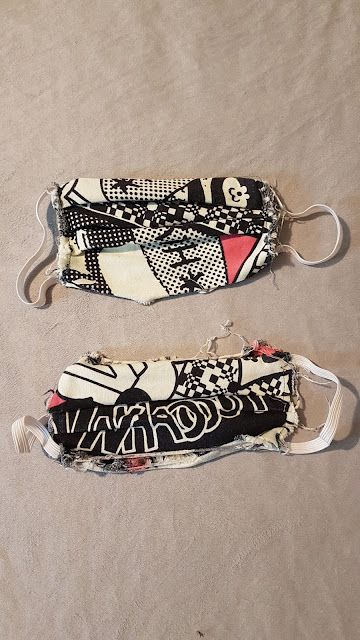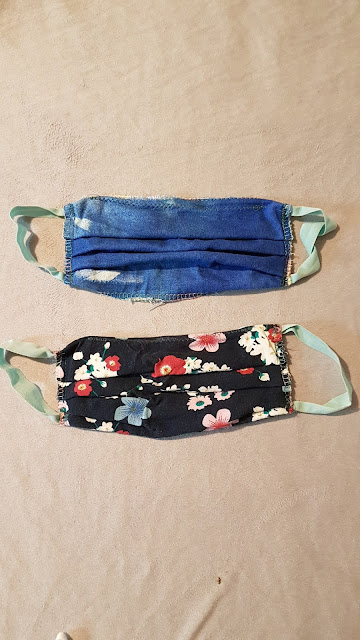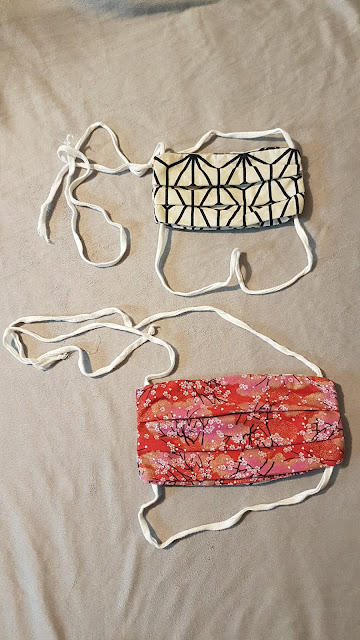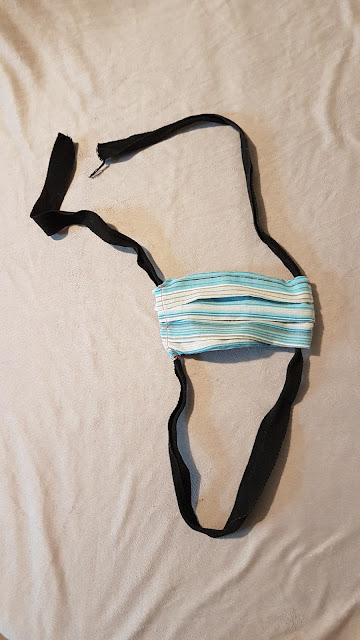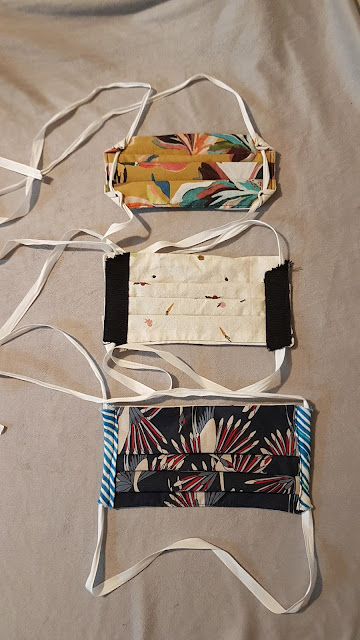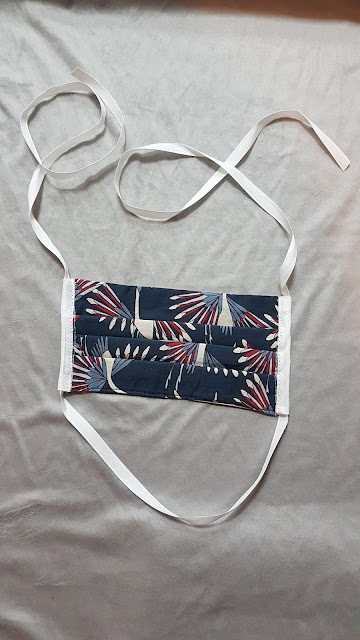I'm trying to think of the right way to write this...
Does anybody else think that the impact of the pandemic has manifested in very specific ways amongst the home sewing community? I'm not necessarily talking about losing creative energy, having no motivation or concentration, or the paradaox of having all the time to stay in and sew but nowhere to wear our finished projects. I'm not even talking about mindfulness via embroidery, yarn or drawing etc. I'm talking about masks.
We may never be able to prove it, but hopefully these little projects have saved lives. No other project I have ever made, or will probably ever make, holds that potential power. I am so used to making projects to bring warmth, fun, joy etc that it was surprising to feel that only now my sewing skills actually mattered.
Offering someone a homemade mask is a pretty radical act. It's an act of love, respect and protection.
Sewing has always had the power to be political and making masks en masse to distribute seemed like a hugely political move for all of us quiet revolutionaries. Making masks and scrubs was a way to protest against the inadequate government response and also to protest against that voice in our heads saying "you can't stay locked down, there must be something you can do!". As manufacturing shut down and PPE supplies dried up, suddenly we had power to step up and help. Small-scale hubs were set up to either alleviate pressure on remaining actual PPE supplies or to help supplement supplies. Millions upon millions of people, making millions upon millions of reusable masks is not to be sniffed at. I'm in favour of nations being able to manufacture their own PPE at scale, but hey, we were faster and more agile - we helped plug that gap.
But enough about the social phenomena - let's talk about the sewing
As sewists we famously don't iterate on our projects too much. Get a garment done, move on to the next one. If you're really diligent you might make a muslin or samples of specific techniques, but mostly we jump around and hope to remember a tweak the next time we make a similar pattern.
So, I figured that it would be interesting to go through the versions of masks I've made over the last year and look at their evolution.
Disclaimer #1
I have been sewing masks privately and giving them away to family and friends. I think I have made about 200 over the last year (this isn't a competition and I know this is much less than a lot of other sewists). I have never sewed masks with the aim of selling them (I have an alright job, there's no need to ask someone to cover my costs) and I haven't been sewing them for a collective. I joined the Mask Makers after Bernadette Banner mentioned it in her video, but it never had massive applicability to the UK. I did use their mask instructions as a basis for my own approach and have seen improvements made to the live google doc. I also joined the local Scrubhub but mostly used it for news because their need for sewers never lined up with my availability. They wound-down once the manufacturing employers came off of furlough. I was never reliable enough to sew for a collective.
Disclaimer #2
I am lax about using the word 'mask'. This is not a medical device, but I prefer the word over 'face covering' so you may see both in this post.
Pattern of Choice: The Rectangle
A word about patterns: I have stuck with the rectangle style consistently because I think it is simple and effective. I can tear fabric along the grains and get a decent number of pieces with almost no waste at all from a piece of fabric.
I also think that you can get a really good fit with a rectangle pattern. Why do I believe in the power of the rectangle when the blue plastic masks fit so badly? Well...let's think about what we know about about garments. One of the hardest parts of the body to fit is the bust. There is a whole industry dedicated to making garments to fit, enhance, reshape, support, compress or contain busts. We judge garments whether they succeed or fail by how garments gap, billow, strain or spread over our busts. In the sewing world we have spent hours poring over FBAs/SBAs, moving bust points etc. Where am I going with this? Well, who on earth thought that a 2-piece darted cup design would fit universally over - potentially - an area of the body even harder to fit than the bust was nuts. You've seen human noses, right?
It was that knit-fabric cartel, wasn't it?
Anyway, I get upset about consumer investigations of homemade masks where they assume we don't know anything about fit. I don't know if this is still true, but everything I read about double-masking was not arguing for better filtration, it was about attempting to improve the seal or fit of the disposable mask. You want to get a good seal on your face covering? In the absence of a specialist, ask a garment sewer to diagnose the fit of your mask. You'll learn something!
Anyway, I have found that a rectangle mask with deep pleats and a nosewire provides lots of scope for extra fabric where you need it (over the nose and chin) and much less where you don't need it (over the cheeks).
Mask #1: The Mod Dress
I made these on 16 March 2020. B and I had just been given our "stay at home" orders from our employers and I felt like I should probably wear something over my nose and mouth when I went to buy groceries. I spent an evening raiding the scraps bag and frantically googling how to make these things and ended up following an Emma One Sock tutorial (long since removed). The tutorial said to use 2x sandwich tie wires across the bridge of the nose. I didn't have any sandwich wire and ended up substituting in 2x 3mm gardening wire strips. I don't remember how the tutorial recommended to sew these in but I was on a zig-zag kick and just stitched over them with a #5 width.
I thought this fabric would be fun to match my Mod Dress for a bit of "stitch courage" while buying our weekly supplies.
I also used spare supplex to make some gloves so I wouldn't touch anything in the shop and share germs. I really hate making gloves and I am really bad at it. I stopped wearing gloves after I tried to manouvre a shopping trolley and realised they had NO grip.
Mask #2: Sea Waves and Jumpsuit
I made these on the first or second weekend after lockdown began. They were a "project of the week" kind of thing and I was mostly raiding my scraps for supplies. I made a couple of face coverings using leftover soft shell from my Mei jacket but I threw those out almost instantly. With hindsight, I wish I'd kept one for reference purposes because the debate has evolved over time regarding hydrophobic fabrics, anti-microbial coatings and other forms of technical textile. It would have been interesting to assess.
The main purpose of this batch was to have something to send to my family in Dorset. I was convinced they would think they were stupid or unnecessary but I was frustrated that we lived far away and I couldn't do anything else to protect or help them. I also wanted them to be early adopters and take face coverings seriously. I spent ages selecting fabric scraps they might like and then using bondaweb to fuse 2-layers of fabric together to get a 2-ply mask. I overlocked all of the edges in rainbow thread.
I also decided that 2x garden wires was overkill and maybe I should try with 1x 3mm wire instead. It worked like a charm.
This was still long before mask-wearing was compulsory in shops/on transport etc and long before western organisations were issuing guidance on what a fabric face covering should be made of/what its construction was. This was long-before shops were selling fabric face coverings too so the standard expectations hadn't been set in the public's mind. I think that by now the BBC had published guidance on how to cut up a sock and wear it over your face.
My elastic ran out while making this batch and I switched to Fold Over Elastic to complete the set.
The family was polite when they received these coverings, but I think I didn't appreciate that maybe faces could be different sizes and that masks might be uncomfortable if they don't fit right. I think the fit issue here was the size of the ear loops and width of the mask - it pulled a bit too tight for them! I was heartened when I found out they were taking face coverings seriously though (sensible lot!). I think that as soon as Amazon started selling fabric face coverings they switched for some new ones from the marketplace.
Mask #3: New method and tie-style
Some time passed. Maybe a month, maybe two...I don't really know. I was keen to do a more systematic approach to mask making because I
wanted to produce better quality than the scrappy ones made to date. We were still deep in The Great Elastic Shortage and I was still working on a make-do with what you have in stock approach. So how do you make face coverings with no elastic on hand? You switch to the tie-back style.
Th obvious advantage to the tie-back style is that it doesn't hang off your ears and therefore the adjustable strap can pull a mask quite tight to your face. One of the best, but probably lesser appreciated advantages to the tie-back style is that if the tie is adjustable, you can adjust the curve of the side of the mask - a more effective version of the "twist the ear elastic on your blue disposable mask" trick designed to make them curve around a face slightly better.
I threw open my stash cupboard and looked for fresh fabric (i.e. not scraps) and found some souvenir fabric from Japan 2019 that would work well. It is a tightly woven cotton in a couple of different designs.
This time I decided to avoid the bondaweb and sewed/overlocked a rectangle with gaps at the corners [for the ties] and in the bottom edge [for turning, for a filter pocket]. I was beginning to think about filter pockets and how they were a useful feature if people wanted to upgrade their face covering when they weren't sure of the provenance of the mask.
I did buy more gardening wire, which didn't suffer as badly as some items in The Great Gardening Rush of 2020. I machine wash my masks and the wire has fared fine until now, so I'll just carry on. I kept 1x3mm garden wire and decided to try zig-zagging through all layers from the outside. I thought that adding the wire as one of the last steps would make it easier to turn the mask right-sides-out but it was very awkward to sew. When wearing the mask the zig-zag topstitching was also scratchy and uncomfortable, so there are only a couple of prototypes with this type of nose-wire.
I had dithered between measured pleats and eyeballed pleats, but Mask Makers had just released a good tip to fold the mask in half, press a crease, then fold 2 edges into the halfway line and press a crease there. It worked really nicely and made things very simple. I like the deep pleats on the masks because they allow for a good curve and tight fit around the cheeks. Sometimes they end up a bit asymmetrical, but it's nothing major.
Mask #4: A Big Batch
This batch was basically a continuation of Mask #3 but with a modified nose wire insertion. I decided to zig-zag over the nose wire, attaching it to the seam allowance on the top edge before turning the mask right-side-out. This looks a little unconventional because there's no topstitching on the finished product but it fits nicely and there's some cushioning/give in the fabric to prevent irritation on the nose.
Mask #5: Ersatz Big Batch
I sewed a lot of masks in the Big Batch and gave them away. I mis-calculated how much cotton tape was required for the ties and ended up harvesting bias binding, trim, ribbon and webbings for a few masks. The webbing was too thick for the tie holes and the bias binding looked shoddy after a couple of washes. I also ended up with more demand for the masks than I had originally made and needed to hastily cut extra masks from more fabric. Unfortunately, some of the supplementary masks were cut from a low-quality [poly]cotton and they pilled in the wash almost immediately.
I made a few different sizes and really liked the smaller version. B found these too small. I received photos of friends wearing them in different sizes (which was heartwarming!) but showed that the larger masks can fit quite big faces and can fit over beards.
Mask #6: Failed Prototypes
Many months later. WHO issues guidance and all home sewists say "wtf is non-fusible polyproylene?!"; Under Armour over-engineers a beautiful mask design for athletes; disposable mask plastic waste is showing up on beaches; shops are abundant with fabric masks; we start thinking about Christmas meetups and going back to work in the office...maybe I've missed the boat and maybe our household is going to get caught short with too few masks (of crappy quality)...variants start showing up and mask guidance changes; 3-layer becomes the product of choice, Germany demands actual FPP-rated masks on public transport; we enter new lockdowns...maybe I have got enough time to sew another batch of masks before they go out of vogue....
We have completed our house move, my brain is starting to think about stuff properly again. My sewing space is set up. I need to replenish my supplies and start researching. There has been some innovation since I last checked. Elastic has returned, online haberdashery tells you which interfacing is recommended as a non-woven filter layer; everyone is keen to sell you their cotton; Prym has packaged up aluminium nose wires (I'll stick with my garden wire thank you!); plastic woggles/adjusters are freely available. While on a late-night millinery binge, I stumble upon Parkin Fabrics which seems to specialise in millinery supplies and surgical-grade woven cotton (?!) - and suddenly I realise that you can overkill a homemade mask.
Regular home sewists sew at a volume where there's no point in creating a certifiable medical device. Frankly, I don't want my masks relied upon as if they're a certifiable medical device. However I want to make an effective mask to help protect the people I care about. And discovering medical grade cotton might be available to lay people by the metre made me realise that I needed to chill out a bit.
I also gave up on the idea of making matching outfit/mask combos because eurgh.
So, I bought 2x quilting cottons from Stoff & Still with little patterns for some subtle fun and 1x cut of Egyptian Cotton from Empress Mills. Holy moly, that Egyptian cotton is lovely. I bought interfacing from William Gee for the filter layer. I bought a lot of cotton tape from William Gee for the tiebacks (and then used all of it making the festive bunting!).
I also bought some elastic from William Gee and some plastic adjusters from MacCulloch & Wallis (I'm a fangirl, what can I say). I figured my family deserve some new improved masks but without ear loops and without a fiddly knot in the back of their heads.
Maybe I should have prototyped this, but I didn't and cut out about 80x masks' worth of fabric rectangles ready to go. I always think that the rectangle style should be fast to sew, but it really isn't. The steps are simple and repeatable but they're not the fastest. I thought I could save time by switching the sewing order, sewing the masks shut (no filter pocket but these are 3-ply) and then folding over the edges to make a casing. I tried this but realised it was far too bulky. And of course, I'd already sewn and pleated all of the rectangles. So I tested a few potential solutions:
Top. Fold over the corners, bar tack them down and thread the cotton tape through. This gave a really bad fit with gapping around my cheeks. It was also very irritating because the tape could be pulled tight over my cheeks and it would chafe.
Middle. Stitch on a petersham casing on a "back" side of the mask. The fit was better on this but the width of the casing took away the flexibility of about 1/4 - 1/3 of the mask and made the edges stick out like wings. Also it was pretty ugly.
Bottom. Make a casing over the edges using bias binding. This worked very nicely, but needed tidying up because the top of the casing was a raw edge and prone to stretching.
Mask #7: Big Batch 2
I made a huge batch using white bias binding with tidy top/bottom edges. Yes, I was annoyed that I had finished these edges on the actual masks and could have achieved less bulk at the edges if I had pre-planned this finish. Oh well.
B lent me a crochet hook to pull the cords through the casing - it made very light work of approx 60 masks that needed to be threaded.
Mask #8: Big Batch with Elastic
I set aside about 20 masks in order to add elastic and plastic adjusters to them instead of cotton tape. This means they don't need a knot at the back of the head. The elastic went through the casing and the plastic adjusters very easily with the help of the crochet hook.
So that's it, a year of mask making. I can't say it's my favourite project but I'm glad that we have a good supply of nice masks. Fingers crossed I don't need to make any more for a while.
That's it for now, what do you think of your homemade masks?
K x
